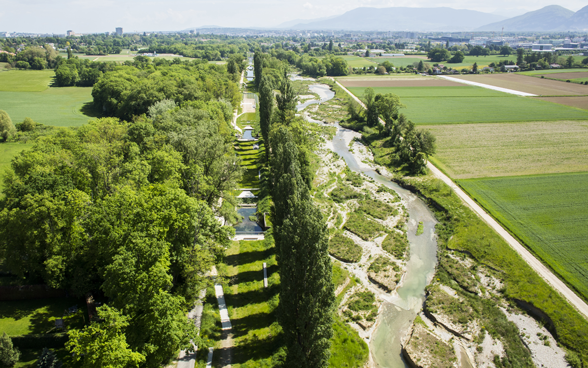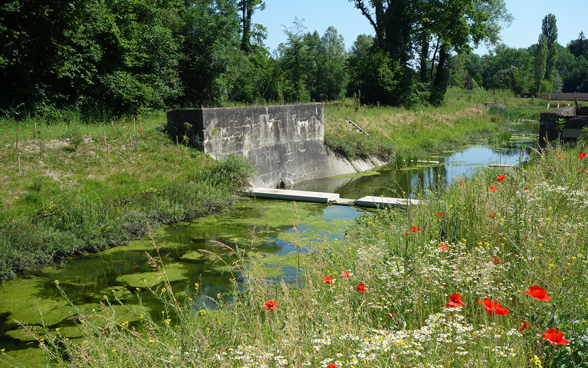16.10.2019 – On 16 October 2019, the Committee of Ministers of the Council of Europe awarded the Council of Europe Landscape Award to the "Renaturation of the watercourse of the Aire" project. With this flagship project of the Republic and Canton of Geneva, Switzerland participated for the first time in this important competition. This project has not only created a valuable habitat for plants and animals, but also a popular recreational space. The preservation of the old man-made channel also makes from it a place of cultural history.

© Fabio Chironi
Canalised or renatured – or both? The Aire is a small river that rises in France at the foot of Mont Salève, flows through the Geneva Basin and joins the River Arve in the Geneva agglomeration. Rather than simply reversing the original canalisation, the renaturation project has left it as a cultural and historical marker of man's influence on the region. The 'Renaturation of the watercourse of the Aire' project is a fine example of the preservation of a cultural landscape that combines both recreational and ecological needs.
On 16 October 2019, the Committee of Ministers of the Council of Europe awarded the Landscape Award to the Aire Renaturation project presented by the Republic and Canton of Geneva. The aim of the award is to draw public attention to the value of landscapes and to raise awareness of their role and the changes affecting them. Conferred every two years since 2009, the Landscape Award will be presented for the seventh time in April 2019.
Previous winners include the Parc de la Deûle in Lille (2009), regeneration of the former mining landscape of Carbonia in Sardinia (2011) and a project to preserve ecological value in the Szprotawa River Valley in Poland (2013).
Human interventions and their effects
Canalisation of the River Aire began in the late 19th century and was long considered an engineering success: a five-kilometre stretch of the watercourse was channelled, eliminating the threat of flooding, and the former wetland turned into fertile farmland. At that time, the radical changes caused to the landscape and the flora and fauna living along the once meandering river were deemed of lesser importance.
In recent years, however, our understanding of the natural world has evolved: the realisation that there are limits to how much we can control nature has led to calls for rivers to be given more space again in order to strengthen natural processes and the interactions integral to biodiversity.

© Superpositions
As early as 1998 the Canton of Geneva launched a renaturation programme with a number of objectives. Increasing the amount of space available to rivers would protect local residents from flooding, restore the rivers into valuable habitats and also provide recreational spaces for the public. In 2000, the Canton launched a design competition for revitalising the River Aire.
The project submitted by Superpositions, an interdisciplinary team of designers, biologists and hydrologists as well as civil and environmental engineers, stood out from the rest: rather than restore the river landscape to its natural state, they planned to do the exact opposite by preserving the traces that man had left on the landscape over the preceding decades. The project was implemented in three stages, starting in 2002. A fourth stage, scheduled for completion by 2022, will enhance the Aire from the village of Certoux to the French border.
A diverse landscape
Today, the banks of the revitalised river are a popular recreational area and a precious habitat for water-loving plants and animals. No longer bisected by a concrete channel, the landscape is much more diverse, with the river flowing in a newly-designed bed, slowly or rapidly depending on the water level, and providing an important habitat for a variety of species.
-©Superpositions_web.png)
© Superpositions
The former channel has been preserved as a reminder of how things have changed: some sections are covered with pergolas and there are picnic areas and steps leading down to the water, creating an attractive space in which people can walk, run and relax as well as a practical thoroughfare for non-motorised traffic. By reading the landscape as an overlay, or 'superposition', of different layers of time, the project designers have created a hybrid of the natural and the artificial that brings the diverse history of the place to life.
The project is valuable not only for its outcome but also for its approach, having evolved in close consultation with residents, farmers, environmental organisations and local government representatives. The involvement of a range of stakeholders has led to widespread popularity and support for the project.
Landscapes provide a variety of benefits that contribute significantly to the well-being of individuals and society. They are a living space for people, animals and plants, they foster familiarity and help us to identify with our surroundings. Landscapes offer numerous opportunities for recreation, sport and exercise, improving our health and so enhancing our quality of life. Last but not least, the landscape draws in tourists and makes Switzerland a desirable place to live and work, which also helps to make the country an attractive centre for business.
The term 'landscape services' encompasses all of these aspects and refers to the overall economic, social and health benefits of landscapes for individuals and society. The value that landscape has for society depends on its quality, and a diverse, well-functioning natural environment contributes significantly to this.
The Federal Office for the Environment (FOEN) identifies four types of cultural landscape services:
- Aesthetic pleasure
- Identification and familiarity
- Recreation and health
- Attractiveness as a place to live and work
Nature and design in harmony
The project, which has won a raft of awards in recent years both in Switzerland and abroad, including the Swiss Heritage Society's Schulthess Garden Prize in 2012 and the Landezine International Landscape Award in 2018, also scored highly with the jury appointed to choose Switzerland's entry for the Landscape Award of the Council of Europe.
The jury felt that it made a forward-looking contribution to landscape development and harmoniously juxtaposed recreation and ecology, while also providing an answer to the topical question of how landscapes should develop near ever more densely populated urban areas.
-©Superpositions_web.png)
© Superpositions
Award ceremony on 10 June 2021
On 10 June 2021, after several postponements amid the pandemic, Switzerland was finally able to celebrate the Council of Europe Landscape Award conferred on the 'Renaturation of the watercourse of the River Aire' project. Representatives of the Council of Europe, the Confederation, the Canton of Geneva as well as the communes along the River Aire and the French Communauté de communes du Genevois came together on the banks of the river to celebrate this achievement. A plaque donated by the Council of Europe was unveiled to mark the occasion. This was the first time Switzerland participated in the competition.
In his speech, Ambassador Christian Meuwly, Permanent Representative of Switzerland to the Council of Europe, noted that the Aire regeneration project was a good example of the development of landscape qualities taking account of both the public's need for recreational space as well as ecological concerns, with the creation of an important biotope for plants and animals. The national jury set up for the competition had highlighted this synergy between the needs of the population and the protection of biodiversity as a key factor in its decision. On this basis, the project was submitted by the Federal Office for the Environment (FOEN) as Switzerland's first ever entry for the Landscape Award. The FOEN sees the winning project as an excellent example of the successful implementation of several federal policies and, in particular, the synergies that exist between them.
Further information
Last modification 16.10.2019





